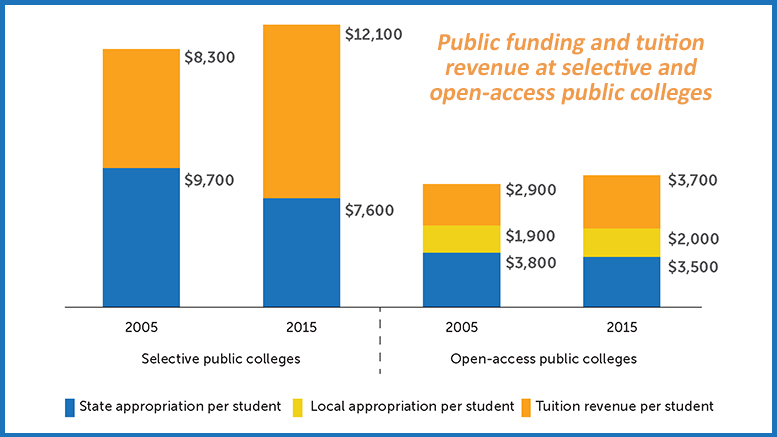A lack of state resources for open-access public higher education institutions such as community colleges is, in part, contributing to an underrepresentation of qualifying minority students at selective public universities, according to a new report.
Spending differences between open-access and selective public colleges have expanded over the past decade, says the report from the Georgetown University Center on Education and the Workforce. While states are, in general, cutting funding to all public colleges, selective public institutions are more than making up for the loss in revenue by increasing tuition, it says. This creates a financial hurdle for many minorities.
“The result is a tiered public higher education system in the United States that inherently favors white students,” the report says.
In 15 states, selective public colleges received at least double in state and local appropriations per student than open-access colleges, according to the report. In 2005, selective public colleges spent $14,300 per student on instructional and academic support, compared to $5,500 at open-access public colleges. That $8,800 gap widened to $10,600 by 2015, when selective schools spent $16,600 per students compared to $6,000 at open-access schools.
In addition, open-access colleges have fewer resources than selective schools to use for hiring instructors. Selective public colleges have 6.8 full-time faculty members per 100 full-time equivalent (FTE) students, compared to 2.7 faculty at open-access colleges. Meanwhile, open-access schools have 5.5 part-time faculty members per 100 FTE students, compared to 2.4 part-time faculty at selective public colleges.
Separate classes
The center did not mince words regarding the funding disparity.
“The funding divide between selective public colleges and the open-access public colleges is due in part to an elite political bargain among legislators, governors, selective public colleges and affluent (mostly white) families,” its report says.
Wealthier families can “tolerate” large tuition increases at selective public colleges because their children get access to a quality, publicly subsidized education. And it’s still a bargain for them compared to tuition at selective private colleges.
“This makes the tuition at selective public colleges affordable and attractive to wealthy families even as they may seem prohibitively expensive to poor families,” the report says.
The testing roadblock
Whites have almost two-thirds (64 percent) of seats at selective public colleges, even though they comprise 54 percent of the country’s college-age population, the report notes. Meanwhile, most blacks and Latino students enroll in “overcrowded and underfunded” open-access colleges, mainly community colleges, it says.
The Georgetown center knocks the argument that the disparity is because blacks and Latinos don’t score as high on standardized tests as whites. It states selective public colleges favor using the test scores because they factor into college rankings, and “colleges have long set prestige as their highest pursuit rather than a commitment to upward mobility for all.”
The SAT and ACT are given more weight than they actually deserve as predictors of completion and success after college, the report says. (Community colleges are increasingly using high school grade point averages and other indicators of success instead of placement tests in determining whether incoming students need development education.)
“The use of test results are arbitrary qualifications for entry into selective colleges has made a mockery of educational opportunity,” the centers says in the report, adding that the tests are a “means of laundering race and class inequity behind a scientific façade of qualitative metrics.”
As an example, the center notes that in 2014 about 341,000 black and Latino high schools seniors scored above average on standardized college-entrance exams, yet only 19 percent of them attended a selective college. Meanwhile, 31 percent of white students who scored above average on a standardized test attended a selective public college.

